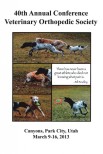Canine hip dysplasia (CHD) is a developmental malformation of the hip joints resulting in secondary joint disease (arthrosis, arthritis) and corresponding clinical symptoms such as pain and lameness. The major cause of CHD is an excessive laxity of the hip joint, characterized by subluxation of the femoral head out of the acetabulum. The aetiology of CHD is not fully understood. Poor quality connective tissue of the joint capsule may play a crucial role. The disease is hereditary, and current data suggest a major gene theory. Heritability may be up to 95 % (!) depending on breed and population studied. Many breed clubs have established a program to control CHD. Diagnosis of CHD is commonly based on radiographic findings in large-scale screening of dogs. Radiographic technique has been standardized worldwide. The dog is deeply sedated or anesthetized to guarantee adequate muscle relaxation. Then it is positioned in dorsal recumbence with the hind limbs extended caudally and the femora parallel to the spine, to the table top and to each other. The patellae are centered over the femoral shafts.
The severity of CHD is judged based on the degree of subluxation and to a lesser degree on the presence and severity of secondary joint disease. It must be noted though that radiographs do not precisely reflect the genetic make up of a dog itself nor the risk for passing CHD to the offspring. Internationally 3 somewhat differing scoring modes are in use: The FCI (Fédération Cynologique Internationale), the OFA (Orthopedic Foundation for Animals), and the BVA/KC (British Veterinary Association/The Kennel Club) mode.
Scoring radiographs for canine Hip Dysplasia - The big three organisations in the world
Date
2008
Journal
EJCAP
Volume
17
Number
2
Pages
135-140









